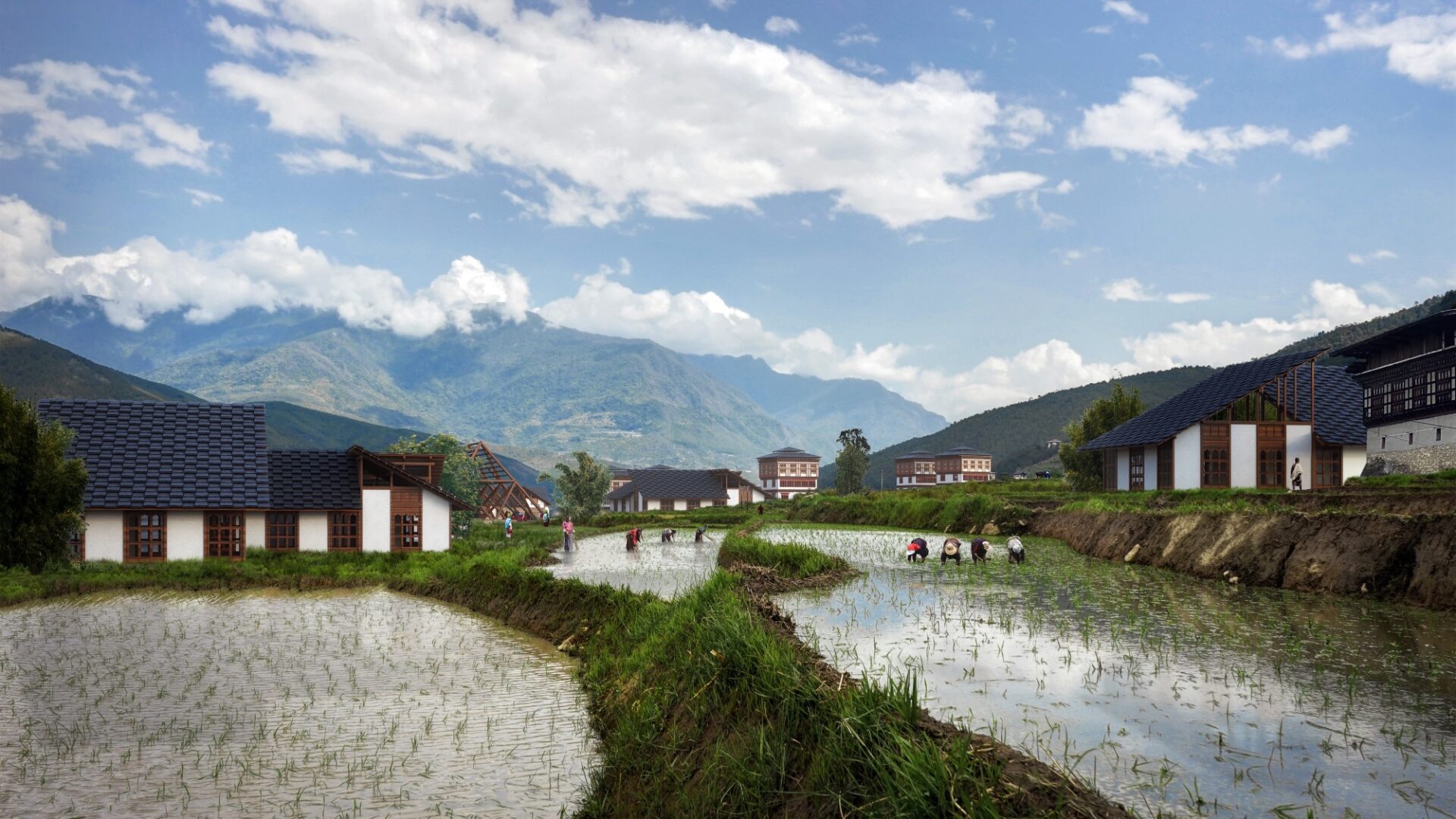BIG Unveils Mindfulness City in Gelephu, Bhutan
‘Mindfulness City,’ is a collaborative effort by architectural firms BIG, Arup, and Cistri, drawing inspiration from Bhutanese culture, the Gross National Happiness index, and spiritual heritage.
 In the 116th National Day address, His Majesty King Jigme Khesar Namgyel Wangchuck outlined plans for a new economic hub in Bhutan, positioned as the world’s first carbon-negative country. Located in Gelephu along the India-Bhutan border, the proposed Gelephu Special Administration Region aims to capitalise on its strategic location and connectivity to South- and Southeast Asia for economic growth.
In the 116th National Day address, His Majesty King Jigme Khesar Namgyel Wangchuck outlined plans for a new economic hub in Bhutan, positioned as the world’s first carbon-negative country. Located in Gelephu along the India-Bhutan border, the proposed Gelephu Special Administration Region aims to capitalise on its strategic location and connectivity to South- and Southeast Asia for economic growth.
The envisioned development includes a new international airport, railway connections, a hydroelectric dam, and public spaces.
The urban design, shaped by the nine domains of the Gross National Happiness index, seeks to accommodate a range of factors, from psychological well-being to cultural diversity. Mindfulness City is strategically positioned to contribute to Bhutan’s economic development through investments in green technology, education, and infrastructure.
The plan aims to amplify the country’s biodiversity by integrating interconnected ecosystems and neighborhoods, adapting to the natural terrain with urban terraces cascading from highlands to lowlands.
Nestled between mountains, forests, and rivers, Bhutan stands as one of the last biodiversity hotspots in the world, with 70% of the country covered in forest. Mindfulness City aims to amplify the country’s abundant biodiversity by emerging as a vibrant tapestry of interconnected ecosystems and lively neighbourhoods shaped by the flow of the 35 rivers and streams that run through the site.
The resulting ribbonlike neighbourhoods resemble paddy fields, forming urban terraces that cascade down from the hills to the valley. The city increases in density from the rural and recreational highlands to the urban and dense lowlands.
“The Gelephu Masterplan gives form to His Majesty’s vision to create a city that becomes a cradle for growth and innovation while remaining founded on Bhutanese nature and culture. We imagine the Mindfulness City as a place that could be nowhere else. Where nature is enhanced, agriculture is integrated, and tradition is living and breathing, not only preserved but also evolved. Shaped by waterways, Gelephu becomes a land of bridges, connecting nature and people, past and future, local and global,” says Bjarke Ingels, Founder and Creative Director, BIG Bjarke Ingels Group.
“The Gelephu Masterplan gives form to His Majesty’s vision to create a city that becomes a cradle for growth and innovation while remaining founded on Bhutanese nature and culture. We imagine the Mindfulness City as a place that could be nowhere else. Where nature is enhanced, agriculture is integrated, and tradition is living and breathing, not only preserved but also evolved. Shaped by waterways, Gelephu becomes a land of bridges, connecting nature and people, past and future, local and global. Like the traditional Dzongs, these inhabitable bridges turn into cultural landmarks, doubling as transportation infrastructure combined with civic facilities. Among these, the Sankosh Temple-Dam embeds the city’s fundamental values into a cascading landscape of steps and landings, that like a 21st century Tigers Nest will be a manmade monument to the divine possibility of a sustainable human presence on earth. Turning engineering into art and turning the forces of nature into power,” says Bjarke Ingels, Founder and Creative Director, BIG – Bjarke Ingels Group.
“Like the traditional Dzongs, these inhabitable bridges turn into cultural landmarks, doubling as transportation infrastructure combined with civic facilities,” explains the architect.
The natural elements and the existing infrastructure, agriculture, and utilities of Gelephu naturally create eleven distinct neighborhoods across the 1000+ km2 area. Each of the eleven neighbourhoods is designed based on the principles of the Mandala: defined by a series of repeating typologies organised symmetrically around a central public space, a gradual transition in density is created, from small buildings dispersed in the landscape in the north to larger footprints within an urban environment in the south.
The neighborhoods within the city, which are divided by rivers, are tied together by three main mobility connections. Occasionally, these double as transportation infrastructure combined with civic and cultural facilities, creating a series of ‘inhabitable bridges’ which are tailored to each of the nine Gross National Happiness domains.
Each of the bridges house key destinations within the city: the new airport, a Vajrayana spiritual center which allows glimpses into the daily practices of the monks and masters of mindfulness; a healthcare center as a meeting between Eastern and Western medicine; a university that exposes its academic activities; a hydroponic and aquaponic greenhouse putting ancient farming practices and modern agro-science on display for the daily commuters; a cultural center to immerse and educate visitors about Bhutanese culture and customs; and a market adorned with Bhutanese textiles.
Intimate streets, paved with permeable pavers provide resilience by allowing stormwater to seep into the ground rather than the sewage system. Local materials – wood, stone, and bamboo – will be used in the new buildings, inspired by vernacular motifs such as rabsel, cornices, ornaments, and roofscapes.
Project facts
Name: Gelephu Mindfulness City
Size: 1000+ km2
Location: Gelephu, The Kingdom of Bhutan
Client: The Kingdom of Bhutan
Collaborators: Arup, Cistri
Project team
Partners-in-Charge: Bjarke Ingels, Giulia Frittoli
Project Manager: Nanna Gyldholm Møller
Design Lead: Dace Gurecka
Team: Anastasiia Golub, Filip Radu, Giancarlo Albarello Herrera, Krisha Arunkumar, Marius Tromholt-Richter, Matthew Goodwill, Monika Dauksaite, Sophie Høg, Xian Chen, Xu Lian
Visualisations: Brick Visual, Atchain, BIG
Animation: Squint/Opera & Brick Visual


















